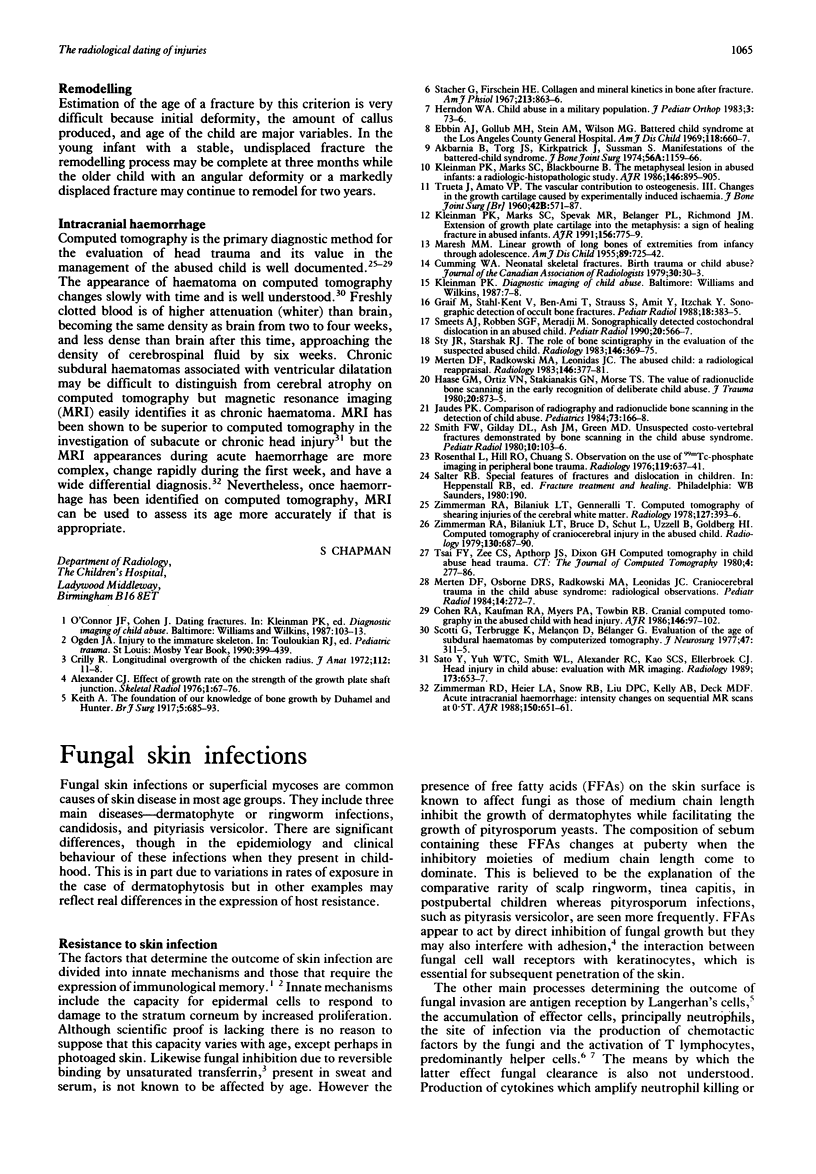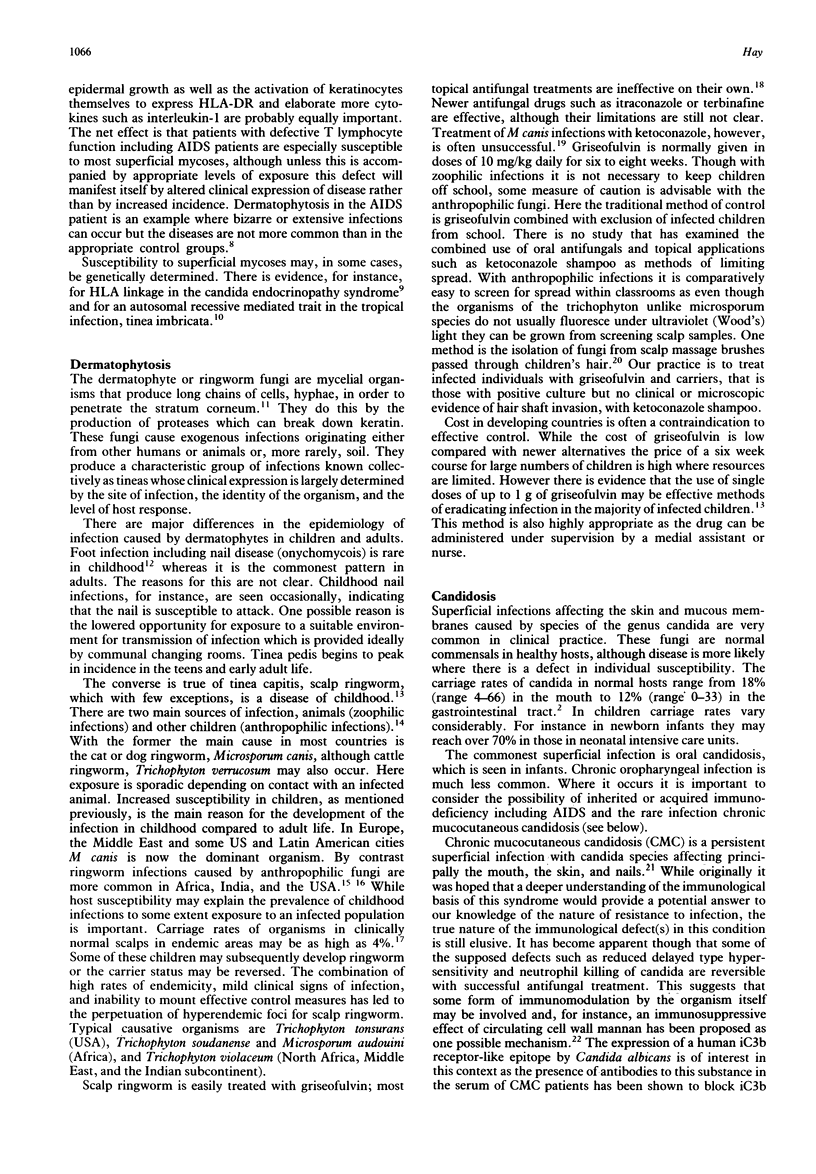Full text
PDF


Selected References
These references are in PubMed. This may not be the complete list of references from this article.
- Ahonen P., Myllärniemi S., Sipilä I., Perheentupa J. Clinical variation of autoimmune polyendocrinopathy-candidiasis-ectodermal dystrophy (APECED) in a series of 68 patients. N Engl J Med. 1990 Jun 28;322(26):1829–1836. doi: 10.1056/NEJM199006283222601. [DOI] [PubMed] [Google Scholar]
- Braathen L. R., Kaaman T. Human epidermal Langerhans cells induce cellular immune response to trichophytin in dermatophytosis. Br J Dermatol. 1983 Sep;109(3):295–300. doi: 10.1111/j.1365-2133.1983.tb03544.x. [DOI] [PubMed] [Google Scholar]
- Broberg A., Faergemann J. Infantile seborrhoeic dermatitis and Pityrosporum ovale. Br J Dermatol. 1989 Mar;120(3):359–362. doi: 10.1111/j.1365-2133.1989.tb04160.x. [DOI] [PubMed] [Google Scholar]
- Bronson D. M., Desai D. R., Barsky S., Foley S. M. An epidemic of infection with Trichophyton tonsurans revealed in a 20-year survey of fungal infections in Chicago. J Am Acad Dermatol. 1983 Mar;8(3):322–330. doi: 10.1016/s0190-9622(83)70034-4. [DOI] [PubMed] [Google Scholar]
- Dankner W. M., Spector S. A., Fierer J., Davis C. E. Malassezia fungemia in neonates and adults: complication of hyperalimentation. Rev Infect Dis. 1987 Jul-Aug;9(4):743–753. doi: 10.1093/clinids/9.4.743. [DOI] [PubMed] [Google Scholar]
- Durandy A., Fischer A., Le Deist F., Drouhet E., Griscelli C. Mannan-specific and mannan-induced T-cell suppressive activity in patients with chronic mucocutaneous candidiasis. J Clin Immunol. 1987 Sep;7(5):400–409. doi: 10.1007/BF00917018. [DOI] [PubMed] [Google Scholar]
- ENGLISH M. P., GIBSON M. D. Studies in the epidemiology of tinea pedis. I. Tinea pedis in school children. Br Med J. 1959 Jun 6;1(5135):1442–1446. doi: 10.1136/bmj.1.5135.1442. [DOI] [PMC free article] [PubMed] [Google Scholar]
- Grant S. M., Clissold S. P. Fluconazole. A review of its pharmacodynamic and pharmacokinetic properties, and therapeutic potential in superficial and systemic mycoses. Drugs. 1990 Jun;39(6):877–916. doi: 10.2165/00003495-199039060-00006. [DOI] [PubMed] [Google Scholar]
- Grant S. M., Clissold S. P. Itraconazole. A review of its pharmacodynamic and pharmacokinetic properties, and therapeutic use in superficial and systemic mycoses. Drugs. 1989 Mar;37(3):310–344. doi: 10.2165/00003495-198937030-00003. [DOI] [PubMed] [Google Scholar]
- Herrod H. G. Chronic mucocutaneous candidiasis in childhood and complications of non-Candida infection: a report of the Pediatric Immunodeficiency Collaborative Study Group. J Pediatr. 1990 Mar;116(3):377–382. doi: 10.1016/s0022-3476(05)82824-0. [DOI] [PubMed] [Google Scholar]
- Jones H. E., Reinhardt J. H., Rinaldi M. G. Model dermatophytosis in naturally infected subjects. Arch Dermatol. 1974 Sep;110(3):369–374. [PubMed] [Google Scholar]
- King R. D., Khan H. A., Foye J. C., Greenberg J. H., Jones H. E. Transferrin, iron, and dermatophytes. I. Serum dematophyte inhibitory component definitively identified as unsaturated transferrin. J Lab Clin Med. 1975 Aug;86(2):204–212. [PubMed] [Google Scholar]
- Krowchuk D. P., Lucky A. W., Primmer S. I., McGuire J. Current status of the identification and management of tinea capitis. Pediatrics. 1983 Nov;72(5):625–631. [PubMed] [Google Scholar]
- Ollert M. W., Wadsworth E., Calderone R. A. Reduced expression of the functionally active complement receptor for iC3b but not for C3d on an avirulent mutant of Candida albicans. Infect Immun. 1990 Apr;58(4):909–913. doi: 10.1128/iai.58.4.909-913.1990. [DOI] [PMC free article] [PubMed] [Google Scholar]
- Pfaller M. A. The use of molecular techniques for epidemiologic typing of Candida species. Curr Top Med Mycol. 1992;4:43–63. doi: 10.1007/978-1-4612-2762-5_2. [DOI] [PubMed] [Google Scholar]
- Rippon J. W. The changing epidemiology and emerging patterns of dermatophyte species. Curr Top Med Mycol. 1985;1:208–234. doi: 10.1007/978-1-4613-9547-8_8. [DOI] [PubMed] [Google Scholar]
- Sams W. M., Jr, Jorizzo J. L., Snyderman R., Jegasothy B. V., Ward F. E., Weiner M., Wilson J. G., Yount W. J., Dillard S. B. Chronic mucocutaneous candidiasis. Immunologic studies of three generations of a single family. Am J Med. 1979 Dec;67(6):948–959. doi: 10.1016/0002-9343(79)90635-1. [DOI] [PubMed] [Google Scholar]
- Serjeantson S., Lawrence G. Autosomal recessive inheritance of susceptibility to tinea imbricata. Lancet. 1977 Jan 1;1(8001):13–15. doi: 10.1016/s0140-6736(77)91653-1. [DOI] [PubMed] [Google Scholar]
- Torssander J., Karlsson A., Morfeldt-Månson L., Putkonen P. O., Wasserman J. Dermatophytosis and HIV infection. A study in homosexual men. Acta Derm Venereol. 1988;68(1):53–56. [PubMed] [Google Scholar]
- Verhagen A. R. Distribution of dermatophytes causing tinea capitis in Africa. Trop Geogr Med. 1974 Jun;26(2):101–120. [PubMed] [Google Scholar]
- Wright S., Robertson V. J. An institutional survey of tinea capitis in Harare, Zimbabwe and a trial of miconazole cream versus Whitfield's ointment in its treatment. Clin Exp Dermatol. 1986 Jul;11(4):371–377. doi: 10.1111/j.1365-2230.1986.tb00477.x. [DOI] [PubMed] [Google Scholar]
- Zurita J., Hay R. J. Adherence of dermatophyte microconidia and arthroconidia to human keratinocytes in vitro. J Invest Dermatol. 1987 Nov;89(5):529–534. doi: 10.1111/1523-1747.ep12461067. [DOI] [PubMed] [Google Scholar]


